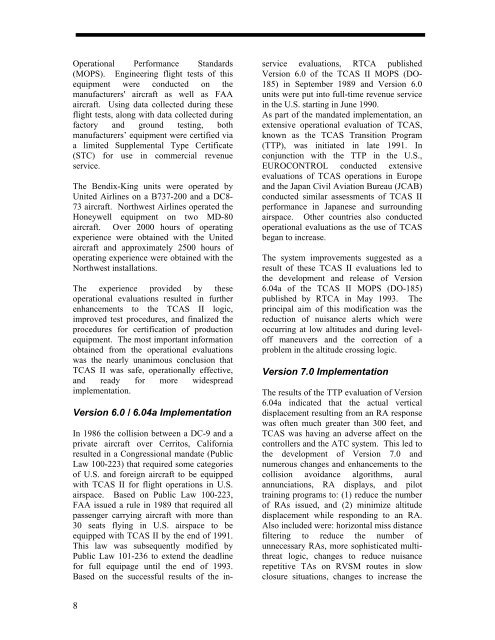You also want an ePaper? Increase the reach of your titles
YUMPU automatically turns print PDFs into web optimized ePapers that Google loves.
Operational Performance Standards<br />
(MOPS). Engineering flight tests of this<br />
equipment were conducted on the<br />
manufacturers' aircraft as well as FAA<br />
aircraft. Using data collected during these<br />
flight tests, along with data collected during<br />
factory and ground testing, both<br />
manufacturers’ equipment were certified via<br />
a limited Supplemental Type Certificate<br />
(STC) for use in commercial revenue<br />
service.<br />
The Bendix-King units were operated by<br />
United Airlines on a B737-200 and a DC8-<br />
73 aircraft. Northwest Airlines operated the<br />
Honeywell equipment on two MD-80<br />
aircraft. Over 2000 hours of operating<br />
experience were obtained with the United<br />
aircraft and approximately 2500 hours of<br />
operating experience were obtained with the<br />
Northwest installations.<br />
The experience provided by these<br />
operational evaluations resulted in further<br />
enhancements to the <strong>TCAS</strong> <strong>II</strong> logic,<br />
improved test procedures, and finalized the<br />
procedures for certification of production<br />
equipment. The most important information<br />
obtained from the operational evaluations<br />
was the nearly unanimous conclusion that<br />
<strong>TCAS</strong> <strong>II</strong> was safe, operationally effective,<br />
and ready for more widespread<br />
implementation.<br />
Version 6.0 / 6.04a Implementation<br />
In 1986 the collision between a DC-9 and a<br />
private aircraft over Cerritos, California<br />
resulted in a Congressional mandate (Public<br />
Law 100-223) that required some categories<br />
of U.S. and foreign aircraft to be equipped<br />
with <strong>TCAS</strong> <strong>II</strong> for flight operations in U.S.<br />
airspace. Based on Public Law 100-223,<br />
FAA issued a rule in 1989 that required all<br />
passenger carrying aircraft with more than<br />
30 seats flying in U.S. airspace to be<br />
equipped with <strong>TCAS</strong> <strong>II</strong> by the end of 1991.<br />
This law was subsequently modified by<br />
Public Law 101-236 to extend the deadline<br />
for full equipage until the end of 1993.<br />
Based on the successful results of the inservice<br />
evaluations, RTCA published<br />
Version 6.0 of the <strong>TCAS</strong> <strong>II</strong> MOPS (DO-<br />
185) in September 1989 and Version 6.0<br />
units were put into full-time revenue service<br />
in the U.S. starting in June 1990.<br />
As part of the mandated implementation, an<br />
extensive operational evaluation of <strong>TCAS</strong>,<br />
known as the <strong>TCAS</strong> Transition Program<br />
(TTP), was initiated in late 1991. In<br />
conjunction with the TTP in the U.S.,<br />
EUROCONTROL conducted extensive<br />
evaluations of <strong>TCAS</strong> operations in Europe<br />
and the Japan Civil Aviation Bureau (JCAB)<br />
conducted similar assessments of <strong>TCAS</strong> <strong>II</strong><br />
performance in Japanese and surrounding<br />
airspace. Other countries also conducted<br />
operational evaluations as the use of <strong>TCAS</strong><br />
began to increase.<br />
The system improvements suggested as a<br />
result of these <strong>TCAS</strong> <strong>II</strong> evaluations led to<br />
the development and release of Version<br />
6.04a of the <strong>TCAS</strong> <strong>II</strong> MOPS (DO-185)<br />
published by RTCA in May 1993. The<br />
principal aim of this modification was the<br />
reduction of nuisance alerts which were<br />
occurring at low altitudes and during leveloff<br />
maneuvers and the correction of a<br />
problem in the altitude crossing logic.<br />
Version 7.0 Implementation<br />
The results of the TTP evaluation of Version<br />
6.04a indicated that the actual vertical<br />
displacement resulting from an RA response<br />
was often much greater than 300 feet, and<br />
<strong>TCAS</strong> was having an adverse affect on the<br />
controllers and the ATC system. This led to<br />
the development of Version 7.0 and<br />
numerous changes and enhancements to the<br />
collision avoidance algorithms, aural<br />
annunciations, RA displays, and pilot<br />
training programs to: (1) reduce the number<br />
of RAs issued, and (2) minimize altitude<br />
displacement while responding to an RA.<br />
Also included were: horizontal miss distance<br />
filtering to reduce the number of<br />
unnecessary RAs, more sophisticated multithreat<br />
logic, changes to reduce nuisance<br />
repetitive TAs on RVSM routes in slow<br />
closure situations, changes to increase the<br />
8



